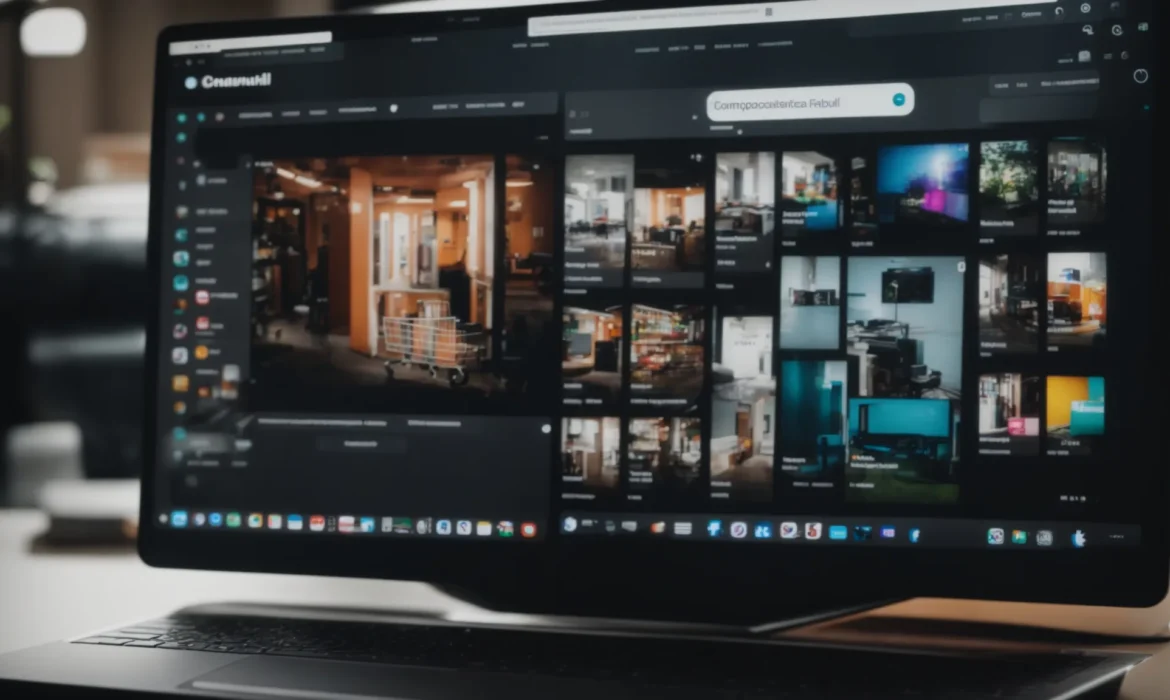
Omnichannel Software: Streamline Your Multi-Channel Strategy
In a digital landscape that stretches like an endless ocean, omnichannel software stands as a lighthouse for businesses navigating the choppy waters of meeting customer expectations across various platforms.
This software doesn’t just create a bridge between ecommerce platforms, social media platforms, and brick-and-mortar stores; it architects a seamless shopping experience that echos the harmony of a symphony.
With the ever-evolving dance of consumer behavior swaying towards a blend of digital and physical experiences, integrating a robust omnichannel strategy becomes not just advantageous but essential.
As the key to unlocking a treasure trove of omnichannel customer experiences, this software integrates inventory management, digital channels, and mobile devices into a cohesive story.
Sail through the nuances of selecting, implementing, and mastering these tools as we unveil the secrets to streamlining your multi-channel strategy.
Keep reading to embark on this pivotal journey.
Key Takeaways
- Omnichannel Platforms Serve as a Swiss Army Knife for Marketers, Blending Various Digital Channels to Meet Customers Wherever They Roam
- A Seamless Shopping Experience Is Central to Meeting and Exceeding the Modern Consumer’s Expectations, Fostering Loyalty and Driving Sales Growth
- Employing Omnichannel Solution Providers Ensures Effective Reach at Every Point of the Customer’s Journey, Enhancing Overall Satisfaction
- Real-Time Data Analytics and Seamless Integration With Existing Systems Are Pivotal in Crafting an Effective Omnichannel Strategy
- Training Teams to Maximize Software Utilization and Setting Clear KPIs Are Critical for Navigating the Complexities of an Omnichannel Approach
What Is Omnichannel Software and Why You Need It

In my journey through the labyrinthine world of ecommerce, I’ve discovered that the best omnichannel platforms are much like a Swiss Army knife for marketers and business owners alike.
By weaving together various digital channels—be it social media platforms, ecommerce platforms, or mobile devices—these innovative tools present a unified front to reach customers wherever they may roam.
The bedrock of this approach lies in its ability to craft seamless shopping experiences, tipping the scales in favor of businesses that can transcend traditional boundaries of inventory management and customer interaction.
With an omnichannel marketing strategy, the maze of customer expectations becomes far less daunting, as it promises to elevate omnichannel customer experiences to new heights, directly impacting sales growth and customer satisfaction.
This idea isn’t just theoretical; it’s a tangible shift in the way we think about connecting with our audience, making it essential to understand the basics of an omnichannel approach and its monumental impact on the landscape of customer experience and sales growth.
Understanding the Basics of Omnichannel Approach
Embarking on an omnichannel approach feels akin to navigating a river that flows through a vibrant ecosystem comprised of social media platforms, ecommerce landscapes, and the ever-evolving terrain of mobile technology. At its core, this methodology is about creating a seamless integration that allows businesses to offer a cohesive customer experience across multiple channels.
Understanding this concept requires grasping that today’s consumers are like butterflies, not content to sip from a single flower but flitting across a garden of digital and physical touchpoints. They might start their journey on a mobile device, flutter over to live chats, and perhaps land finally on a social media platform: all in pursuit of the seamless shopping experience they now expect as standard. This complexity and fluidity underscore the importance of employing omnichannel solution providers to ensure that businesses can effectively reach customers at each point in their journey:
| Touchpoint | Role in Omnichannel Strategy | Impact on Customer Experience |
|---|---|---|
| Mobile Devices | Starting Point for Many Consumers | Immediacy and Accessibility |
| Live Chats | Real-time Customer Service | Personalized Support and Engagement |
| Social Media Platforms | Connectivity and Engagement | Strengthened Community Feel |
The Impact on Customer Experience and Sales Growth
Stepping into the arena of omnichannel customer experiences, I’ve beheld the significant uplift in both customer satisfaction and sales growth. This evolution transforms the shopping journey into a symphony, where every note plays in harmony across a spectrum of digital and physical touchpoints: a true testament to the power of a meticulously crafted omnichannel marketing strategy.
The magic of this approach doesn’t merely lie in the seamless shopping experience but in how it meticulously meets and exceeds customer expectations, fostering loyalty that’s as deep as the ocean. Imagine the profound impact on sales growth when a customer feels seen, heard, and valued across every interaction they have with your brand:
- A sense of trust develops, encouraging repeat business and word-of-mouth recommendations.
- Analytics from these varied interactions provide invaluable insights, allowing for more targeted and effective marketing efforts.
- Overall, this holistic view strengthens not just the bottom line but the very fabric of customer relationships.
Embarking on the odyssey of omnichannel software illuminates the path to unparalleled customer satisfaction. Now, let us unveil the essential features that transform this software into a cornerstone of your business success.
Key Features to Look for in Omnichannel Software

As I’ve waded deeper into the complexities of orchestrating a multi-channel strategy, I have found that the fulcrum of success often rests on the capabilities of omnichannel software to not only intertwine with existing systems but also to harness the might of real-time data analytics and reporting tools.
These aspects are not merely checkboxes on a list of attributes; they embody the heart and soul of what transforms a good strategy into a grand masterpiece.
Integration capabilities ensure that the transition is as smooth as if silk threads were weaving through a tapestry, facilitating a seamless experience that speaks volumes of efficiency and harmony.
Meanwhile, the potency of real-time data analytics casts a beacon of insight, guiding decisions with the precision of a navigator charting a course through uncharted waters.
It is within these realms that the true value of omnichannel software is unveiled, standing as a lighthouse for businesses seeking to streamline their multi-channel strategies in a sea of perpetually shifting customer expectations and digital landscapes.
Integration Capabilities With Existing Systems
In my exploration of omnichannel platforms, a revelation unfolded: the profound significance of integration capabilities with existing systems. This seamless merger acts as the backbone, ensuring that the diverse array of digital channels and ecommerce landscapes can communicate like old friends, creating a cohesive narrative across every interaction.
As I journeyed further, it became clear that the harmony between an omnichannel solution and a company’s pre-existing infrastructure is akin to a conductor orchestrating a symphony. Every system, from inventory management to customer service frameworks, must perform in concert, eliminating any discord that may disrupt the customer’s seamless shopping experience.
Real-Time Data Analytics and Reporting Tools
In my quest to dissect the essence of omnichannel efficiency, I’ve been captivated by the prowess of real-time data analytics and reporting tools. These instruments are the navigators in the odyssey of understanding customer behaviors, allowing businesses to steer in the direction of success with the precision of an expert sailor against the unpredictable seas of market trends.
Real-time data analytics evoke the image of a lighthouse amidst a foggy night, illuminating paths previously shrouded in obscurity. With these tools, the ability to adapt and respond to customer interactions as they happen transforms into a palpable reality, painting a vivid picture of customer desires and expectations on the canvas of strategic decision-making.
Now that we’ve unveiled the treasure trove of essential features within omnichannel software, let’s pivot our journey towards orchestrating an omnichannel strategy with precision and finesse. Brace yourself for the transformative leap from theory to action, igniting the path to unparalleled customer experiences.
Implementing Your Omnichannel Strategy Effectively

Embarking on the journey to effectively implement an omnichannel strategy is akin to setting sail on a vast sea, with the winds of digital transformation propelling us forward.
In order to navigate these waters with finesse, two pivotal beacons must guide our way: Setting clear objectives and KPIs for success, and training our team to maximize software utilization.
With these elements as our compass, we chart a course toward not only meeting but exceeding the seamless shopping experience that our customers yearn for.
It’s about harmonizing the intricate parts of our omnichannel machinery to perform in symphony, ensuring each note resonates with the melody of our brand promise.
Setting Clear Objectives and KPIs for Success
In my pursuit of orchestrating an effective omnichannel strategy, I’ve learned the significance of etching out clear objectives and KPIs (Key Performance Indicators) from the get-go. This strategy carves a path through the dense forest of multi-channel complexities, serving as a compass that guides every decision, every tactic, towards a cohesive goal.
Enlightenment dawned upon me as I understood that without these guiding stars, efforts risk being scattered like leaves in the wind, making it crucial to establish measurable goals that align with the overarching vision of delivering exceptional omnichannel customer experiences. These benchmarks become lighthouses, offering not just direction but also a means to assess the efficiency and impact of our omnichannel endeavors, ensuring we are on course towards enriching the seamless shopping experience that our customers treasure.
Training Your Team to Maximize Software Utilization
Embarking on the omnichannel journey, I recognized the paramount importance of arming my team with the knowledge to wield our chosen software like master craftsmen. Through comprehensive training sessions, we transformed every user interface click and dashboard analysis into an art form, optimizing our strategy to meet every nuanced demand of our omnichannel landscape.
It dawned on me that the success of our omnichannel strategy hinged not just on the robustness of the software itself, but on the proficiency with which my team could navigate its complexities. Tailored training programs became our bridge, converting potential into mastery, ensuring that our use of omnichannel software was not merely effective, but exceptionally so, elevating our customer experience to unprecedented heights.
With your omnichannel strategy blueprint in hand, the adventure escalates. Let’s tackle the dragons of omnichannel retail challenges next, ensuring your quest for seamless integration is victorious.
How to Overcome Common Challenges in Omnichannel Retail

In my voyage across the omnichannel oceans, I’ve encountered formidable waves, two of which – inventory management mishaps and the struggle to maintain a consistent brand voice across all harbors – often threaten to capsize even the most sturdy of retail ships.
Addressing these challenges is akin to navigating through a storm; it requires finesse, strategic foresight, and a crew adept at using the sophisticated compasses and maps that omnichannel software provides.
By tackling inventory management head-on, we ensure that every product, like a trusted compass, finds its way accurately into the hands of awaiting explorers, no matter their location.
Similarly, weaving a consistent brand narrative across each channel is like setting a course by the stars, guiding every customer journey with the light of our brand’s ethos.
Let’s embark on a detailed exploration of how to navigate these challenges, ensuring smooth sailing ahead.
Addressing Inventory Management Issues
In my odyssey through the tumultuous seas of omnichannel retail, addressing inventory management issues emerged as a beacon of light guiding towards operational harmony. This challenge, seemingly Sisyphean at times, necessitated a deep dive into the mechanics of how omnichannel platforms could transform chaos into order, ensuring that every product danced to the rhythm of demand and supply with the grace of a well-rehearsed ballet.
The revelation struck me as I pieced together the puzzle; sophisticated inventory management embedded within omnichannel software was the alchemist’s stone. It had the power to transmute fragmented stock levels into a golden, unified view, enabling my team and I to promise and deliver on the seamless shopping experience our customers didn’t just desire but had come to expect. This pivotal adjustment in our strategy sang a harmonious melody, synchronizing the pulse of our supply chain with the heartbeats of our customer expectations.
Ensuring a Consistent Brand Experience Across Channels
Navigating through the kaleidoscope of channels to ensure a consistent brand experience is akin to conducting an orchestra where every instrument’s tone must harmonize with the symphony’s opus. My foray into this part of the omnichannel journey revealed the subtleties of echoing our brand’s ethos across the digital expanse—from the buzzing conversations on social media platforms to the intimate dialogues through mobile devices and live chats.
The revelation was illuminating; fostering a uniform brand voice across every medium became a linchpin in magnifying our reach and resonating with the audience’s core. By meticulously crafting messages that align with our brand’s values and imagery, we established a coherent narrative that customers could identify with, no matter the channel. This strategic cohesion turned every touchpoint into a chapter of our brand’s story, drawing customers deeper into the experience we wish for them to live and breathe.
Navigating the maze of omnichannel retail challenges is only the first step. Let’s dive into the realms of success stories to see these strategies come to life!
Case Studies of Successful Omnichannel Implementations

Peering behind the curtain of successful omnichannel implementations, we uncover the strategies that have propelled leading retail brands into the pantheon of customer satisfaction and operational efficiency.
This segment is aimed at divulging the essence and core lessons derived from their journeys.
Not content with mere surface-level observations, my aim is to distill the best practices and shared wisdom that these titans of industry have generously left in their wake.
In doing so, we’ll navigate through the intricacies of their strategies, from the starting line of conception to the victory lap of execution, ensuring a treasure trove of insights for those keen on crafting their own legendary omnichannel saga.
Analyzing Strategies From Leading Retail Brands
Peering through the looking glass into the world of leading retail brands, my curiosity uncovered tales of omnichannel success that transcend conventional boundaries. Their strategy, akin to an architect meticulously designing a multifaceted structure, leveraged the best omnichannel platforms to create experiences that resonate with the heartbeats of their diverse audience, seamlessly integrating digital channels, ecommerce platforms, and physical stores into a unified symphony.
Their narrative was not just about employing technology but about reimagining the very essence of customer engagement. By interweaving social media platforms, live chats, and mobile devices, these pioneers crafted a scaffold that elevated inventory management to an art form, ensuring products danced elegantly across channels to meet customer expectations. This mastery in orchestrating a seamless shopping experience served as a beacon, guiding my endeavor to mirror such innovation within my own omnichannel strategy.
Lessons Learned and Best Practices Shared
In dissecting the triumphs of those who’ve mastered the omnichannel approach, a poignant lesson emerged: embracing flexibility and adaptability in strategy is not just beneficial; it’s crucial. These successful entities taught me that the terrain of customer engagement is ever-changing, necessitating a willingness to evolve with both technological advances and shifting customer attitudes.
Another profound insight gleaned from these omnichannel luminaries is the undeniable power of data-driven decision making. My exploration revealed that those who lead the pack in customer satisfaction and operational efficiency are those who harness the vast seas of data at their disposal. They navigate by these stars, tailoring customer experiences to not only meet but exceed the myriad of customer expectations, painting a mosaic of success with each interaction.
Conclusion
In conclusion, the adoption of omnichannel software emerges as a pivotal strategy for businesses aiming to navigate the complex landscape of modern retail and eCommerce.
Seamlessly integrating various digital channels, including social media, eCommerce platforms, and mobile devices, omnichannel solutions enable businesses to offer cohesive, personalized customer experiences across all touchpoints.
The essence of its importance lies in its capacity to meet and exceed the evolving expectations of consumers, fostering a sense of trust and loyalty that directly impacts sales growth and customer satisfaction.
By leveraging real-time data analytics and ensuring seamless integration with existing systems, businesses can craft a nuanced, effective multi-channel strategy that harmonizes their operations and magnifies their brand voice across platforms.
Therefore, investing in omnichannel software is not just a step but a leap towards operational excellence and profound customer engagement, setting the stage for sustained growth and success in the digital age.










